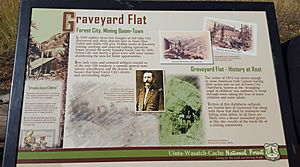Forest City, Utah facts for kids
Quick facts for kids
Forest City
|
|
|---|---|

Scenes in American Fork Canon, 1876: 1. Mt. Aspinwall or Lone Mountain. 2. Rock Summits. 3. Picnic Grove, Deer Creek. 4. A quiet Glen. 5. Hanging Rock. 6. Rock Narrows.
|
|
| Country | United States |
| State | Utah |
| County | Utah |
| Established | 1871 |
| Abandoned | 1880 |
Forest City is a ghost town located in Utah County, Utah, United States. It sits in a valley called Dutchman Flat, high up in American Fork Canyon, within the Uinta National Forest. This town was a silver mining community that existed from about 1871 to 1880.
Forest City grew because of a large smelter built there. A smelter is like a big oven that heats up ore (rock with metal inside) to get the valuable metal out. This smelter processed silver from nearby mines. A special train, the American Fork Railroad, was supposed to reach Forest City. But it never made it all the way due to tough mountain terrain. This made it too expensive to move the silver ore. When the smelter, mines, and railroad stopped working, Forest City became a ghost town.
Contents
A Town Built on Silver: Forest City's Story
How Forest City Began
In the late 1860s, people found silver in a place called Little Cottonwood Canyon. Soon after, prospectors (people looking for valuable minerals) crossed the mountains. They found even more silver in American Fork Canyon. The biggest mine there was the Miller Hill Mine.
In 1871, a company from New York City bought the Miller Hill Mine. They built a huge smelter at Dutchman Flat. It was called the Sultana Smelting Works. This smelter was very expensive to build. It employed 250 to 300 workers in its first year. The town that grew around this busy smelter was named Forest City.
The Railroad Challenge
The smelter was very good at producing silver. But it was hard to move all the silver and ore out of the canyon. To solve this, the company started the American Fork Railroad Company in 1872. They planned to build a special narrow train track. This track would go from the city of American Fork all the way up the canyon to Forest City.
Construction on the railroad began in May 1872. By August, the tracks had reached the mouth of the canyon. However, building a railroad through the rugged mountains was very difficult.
Life and Challenges in Forest City
By late 1872, winter weather forced the mines and smelter to close for the season. At that time, about 500 people lived in Forest City. The town had important places like a sawmill, two general stores, hotels, houses, and a popular saloon.
That winter, a serious illness spread through the town. It caused many people to get sick, and some, including 11 children, sadly passed away. They were buried in a small cemetery nearby, which became known as Graveyard Flat.
The exact number of people who lived in Forest City is not fully known. Some estimates say there might have been as many as 2,000 to 3,000 people at its busiest time. There were enough children that a school was started for them. A dairy farm also supplied the town with milk and butter. Many kilns (special ovens) were used to make charcoal for the smelter.
Why Forest City Became a Ghost Town
Between 1874 and 1876, the silver mines in American Fork Canyon started to run out of high-quality ore. This meant there wasn't as much valuable silver left to dig up. Even though new silver veins were found further up the canyon, the area was very rugged. It was too hard and slow to develop these new mines.
To try and make money, the railroad started taking tourists on sightseeing trips up the canyon. But it wasn't enough. The Miller Hill Mine stopped producing silver by 1874. It opened briefly again the next year but then closed for good. The Sultana Smelter was taken apart in 1876. At this point, Forest City was clearly shrinking.
The other mines in the canyon weren't rich enough to keep the railroad going. In June 1878, the American Fork Railroad closed down. It was the first railroad in Utah to go out of business. By 1880, Forest City was completely deserted.
What's Left of Forest City Today?
Not much remains of Forest City today. You can still see the foundations of the old smelter and some houses. The cemetery at Graveyard Flat was preserved for many years. However, over time, people drove snowmobiles and all-terrain vehicles over it. They even tore down the fence around it.
By 2004, only a wooden sign was left at the cemetery. But in September 2012, on National Public Lands Day, Forest Service workers and volunteers helped fix it. They built a new, stronger fence around the graveyard. They also put up two new signs that tell the history of the town and the cemetery.




